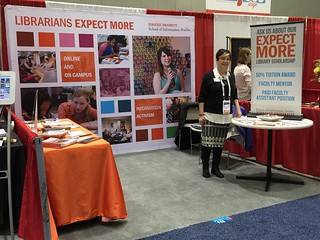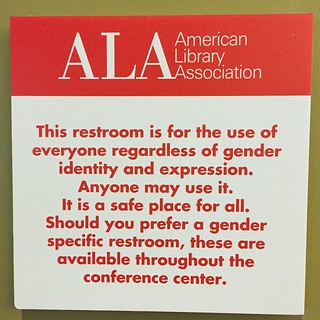Occasionally I've had a graduate student who is interested in Canadian copyright law. One of my former students found this LibGuide on the Canadian law. The site is specifically for Northern Alberta Institute of Technology staff and students, and clearly useful for others.
Monday, February 29, 2016
Thursday, February 18, 2016
The1996 Chafee Amendment: Reproduction for blind or other people with disabilities
 |
| An open book on brown leaves |
During his talk, Harpur used phrases such as book famine and digital apartheid, which really convey the severity of the problem. He spent a good portion of his talk on who to sue when texts are not available for those with access to print disabilities. The two choices in higher education are the publisher and the university. While suing is not the first option, when it is the only recourse, Harpur noted that a resolution can take years. Those years can set the student back in terms of graduating, employment, and salary. For a faculty member, it could stall the person's research and scholarship.
Harpur also talked about the difference between the various types of ebooks and what people really need. For example:
- While a digitized work will be readable by screen reading software, it may be hard to navigate. Can the person move from section to section easily?
- An ebook may work well with a screen reader, but what about with enhancements like videos? Are they usable by someone with visual disabilities?
- Is all of the same information from the print version available in the digital version, and in a way that is accessible to all (e.g., tables, graphs, pictures)?
- Can a person cite from the digital version so that the citations make sense to someone looking at the print version?
Resources:
Thursday, February 11, 2016
ALAMW16 : The Exhibitors and a Final Wrap-Up
 | |
| Sari Signorelli at the SU booth |
The American Library Association Midwinter Conference was held in Boston on Jan. 8-12. The conference attracted 6,941 attendees and 3,879 exhibitors for a total of 10,820. Among the booths was one from Syracuse University and I worked the booth on Saturday and Sunday. Working an exhibit booth provides a very different point of view of a conference, especially when thinking about who comes into the Exhibit Hall.
Exhibitors comprise one of the economic engines behind most conferences. Exhibitors come with the aim of talking with conference participants about their products and services. At ALA, there are many publishers in the Exhibit Hall, who attract attention because they are giving away books and having author signings. The rest of the exhibitors hope that people will seek them out or perhaps find them because they are wandering the Exhibit Hall. Since many of the people who attend Midwinter are leaders (and thus people who have influence), it is hoped that they will come to the Exhibit Hall and be willing to truly engage with the products and services. However, at Midwinter, the Exhibit Hall had some quiet periods and it was clear that not all 10,000 people came into it. I suspect that the leaders were tied up by meetings, while others may have not heard the sirens song. Still I did talk to some librarians from New Hampshire, who had specifically come to the Exhibit Hall on a day-trip. Were exhibitors saddened by the foot traffic? Yes, some were. Hopefully, ALA - and other conferences - can find ways of getting people into the hall, so that exhibitors stay engaged.
 While I'm thinking about the conference, kudos to ALA for its work to provide an inclusive atmosphere. ALA has a code of conduct, which was highly visible. They had a New Mother's Room and gender neutral restrooms. Signage said that every room has seating reserved for those who use mobility devices (like a wheelchair). Buses were available to take people between ALA venues, which was greatly appreciated. With over 10,000 people in attendance, some events were not in the convention center and many people were in hotels that were not within walking distance of the convention center (or each other).
While I'm thinking about the conference, kudos to ALA for its work to provide an inclusive atmosphere. ALA has a code of conduct, which was highly visible. They had a New Mother's Room and gender neutral restrooms. Signage said that every room has seating reserved for those who use mobility devices (like a wheelchair). Buses were available to take people between ALA venues, which was greatly appreciated. With over 10,000 people in attendance, some events were not in the convention center and many people were in hotels that were not within walking distance of the convention center (or each other).Because of the size of the conference, there are meetings that are co-located with it. Several MSLIS programs met with the ALA Committee on Accreditation as part of their accreditation review. I'm pleased that the MSLIS program at Syracuse University was reaccredited for seven years (the maximum length of time). Our next self-study will occur in 2022! I led our effort and so this is a huge weight off my shoulders.
Finally, because of the size of the conference, it is a time to get together with colleagues whom you might see infrequently. Why attend a conference? One of the answers truly is "to maintain my professional network." Thanks to Brent Mai, Paul Signorelli and others for the conversations and the assurance that I would not lose weight while in Boston!
Subscribe to:
Comments (Atom)
